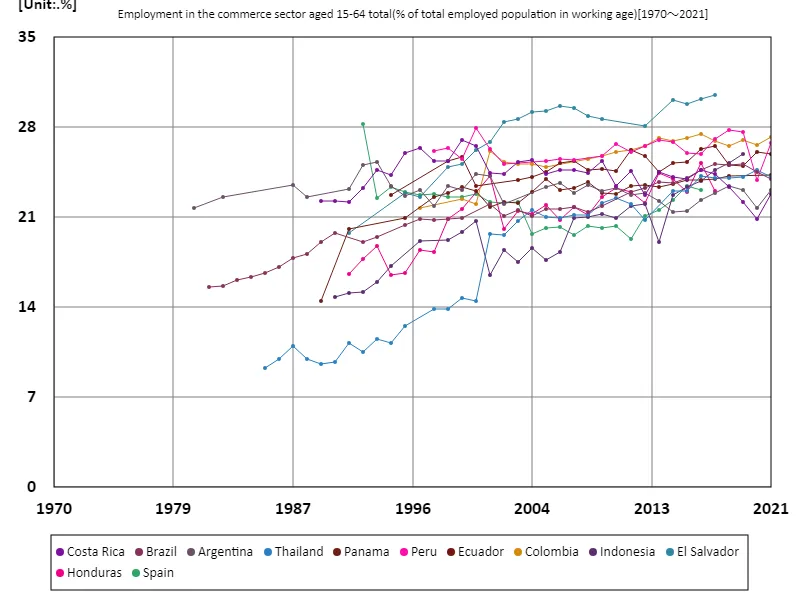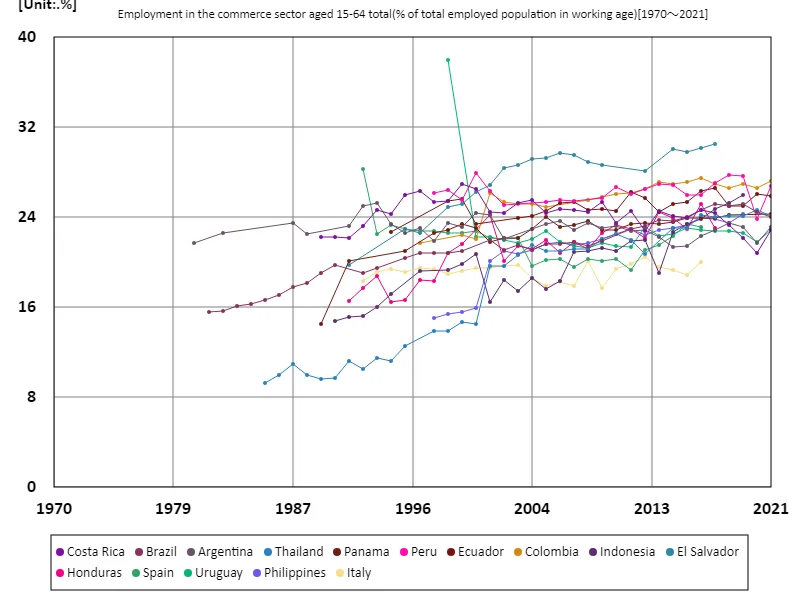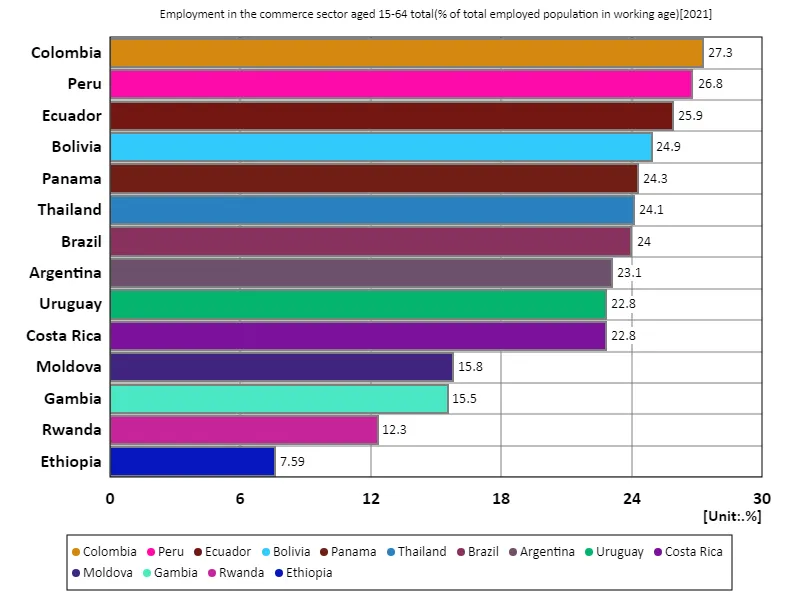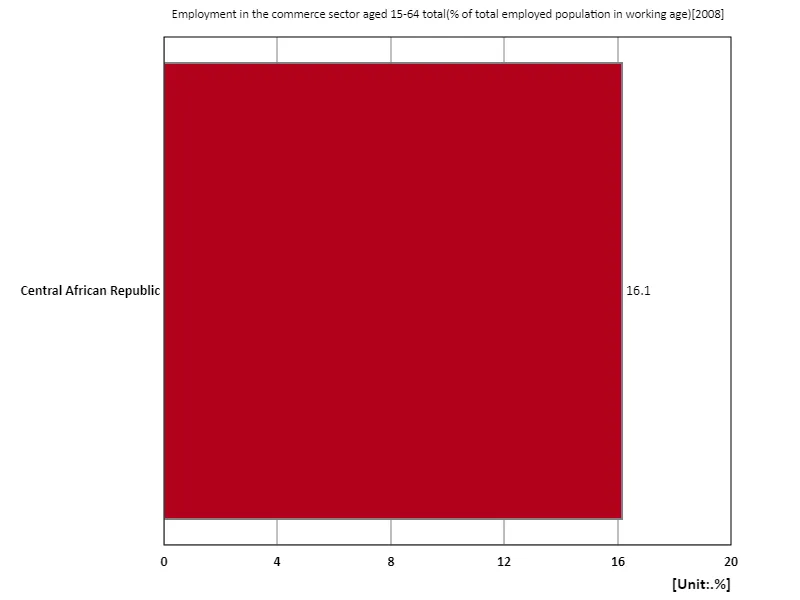- Abstract
- Employment rate for all 15-64 year olds, trade sector (percentage of working age working population)
- Employment rate in the trade sector for all 15-64 year olds (percentage of working-age employed population) (Worldwide)
- Employment rate for all 15-64 year olds in the trade sector (percentage of working age working population) (Worldwide, latest year)
- Employment rate for all 15-64 year olds in the trade sector (percentage of working-age population) (region, latest year)
- Reference
Abstract
Colombia’s high commercial employment rate of 27.3% in 2021 indicates that the commercial sector plays a vital role in the country’s economy. Over the past few decades, the commercial sector has grown alongside the expansion of the service industry, with retail and food service in particular creating jobs. This trend has been fuelled by increasing urbanisation and the expansion of the middle class. On the other hand, the high employment rate in the trade sector may be out of balance with other industries, so diversifying the economy is a challenge. Colombia’s job market is dominated by the trade sector, but sustained economic growth requires the development of other industries.
Employment rate for all 15-64 year olds, trade sector (percentage of working age working population)
Looking at data on employment rates in the commercial sector for working-age groups aged 15-64 from 1980 to 2021, El Salvador recorded the highest rate in 2017 at 30.5%. This high employment rate reflects El Salvador’s heavy reliance on the commercial sector, particularly retail and services. The commercial sector’s large share of employment in the overall employment market is driven by rapid urbanization and increasing consumption of services. In El Salvador, the structure of the economy is heavily dependent on the commercial sector, which has led to a lack of industrial diversification. The current figure of 100% compared to the peak suggests that trade employment is stabilising at a high level, but at the same time growth in other industrial sectors may be slowing. An economic structure that is overly dependent on the commercial sector can make the country vulnerable to external shocks and economic fluctuations, so balanced economic development will be required.


The maximum is the latest one, 30.5% of El Salvador
Employment rate in the trade sector for all 15-64 year olds (percentage of working-age employed population) (Worldwide)
Based on data from 1980 to 2021, Uruguay recorded a very high level of employment in the commercial sector in 1998, at 38%. This high ratio reflects the central role of the commercial sector in the Uruguayan economy. The large proportion of employment in the commercial sector is due to the strong consumer activity in the domestic market and the structure of the economy which is heavily dependent on commercial services. Compared to the peak in 1998, the current employment rate of 60.1% reflects the increased importance of the trade sector. Uruguay’s commercial sector has grown over the past few decades, driven by increasing urbanization and rising consumption of services. While trade employment is growing, industrial diversification and manufacturing development may be lagging behind relatively. Over-reliance on the trade sector can make the economy more vulnerable, so the development of other industrial sectors and economic diversification are important for sustainable growth. Uruguay’s challenge going forward will be to maintain growth in its commercial sector while striking a balance across its economy.


The maximum is 38%[1998] of Uruguay, and the current value is about 60.1%
Employment rate for all 15-64 year olds in the trade sector (percentage of working age working population) (Worldwide, latest year)
According to 2021 data, Colombia recorded the highest employment rate in the trade sector among all working-age groups (15-64 years) at 27.3%. The data shows that the commercial sector occupies an important position in the country’s labour market. While the average employment rate in the trade sector is 21.2%, Colombia’s high rate reflects the strong domestic consumer activity and expansion of the services sector. Countries with high trade sector employment generally have retail and service industries at the core of their economies, which act as a source of economic growth. However, while employment in the commercial sector is high, the manufacturing and technology industries may be relatively underdeveloped. When the commercial sector dominates, as in Colombia, other industries need to be developed and balanced to ensure economic stability and diversity. The ”total 297%” figure is an aggregate figure for each country, as employment rates in the commercial sector were reported in multiple countries, demonstrating widespread recognition of the importance of employment in the commercial sector. Overall, trends in employment in the trade sector reflect the structure of the economy and market needs, suggesting that the development of diversified industries is essential for sustainable economic growth.


The maximum is 27.3% of Colombia, the average is 21.2%, and the total is 297%
Employment rate for all 15-64 year olds in the trade sector (percentage of working-age population) (region, latest year)
According to 2008 data, the service sector employment rate for all 15-64 year olds in the commercial sector is highest in the Central African Republic at 16.1%, compared to the overall average of 16.1%. This consistency in figures indicates that the Central African Republic is in a unique position in trade sector employment, but the same average and total values suggest that other countries may have had similar employment rates. The data show that in 2008, trade employment within the services sector was relatively evenly distributed in many countries. In countries where service sector employment is concentrated in the trade sector, trade activity plays a central role in the economy while development of other service and manufacturing industries is limited. While commercial activity is important, diversifying the economy and balancing industries can be a challenge, especially in countries with a prominent commercial employment sector such as the Central African Republic. An economic structure dependent on the trade sector can increase vulnerability to external shocks and economic fluctuations, so industrial diversification is important for sustainable economic growth.


The maximum is 16.1% of Central African Republic, the average is 16.1%, and the total is 16.1%



Comments